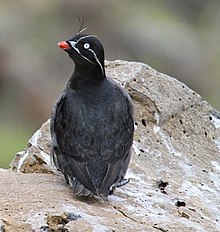Whiskered auklet
| Whiskered auklet | |
|---|---|

| |
| Scientific classification | |
| Domain: | Eukaryota |
| Kingdom: | Animalia |
| Phylum: | Chordata |
| Class: | Aves |
| Order: | Charadriiformes |
| Family: | Alcidae |
| Genus: | Aethia |
| Species: | A. pygmaea
|
| Binomial name | |
| Aethia pygmaea (Gmelin, JF, 1789)
| |

| |
The whiskered auklet (Aethia pygmaea) is a small seabird of the auk family. It has a more restricted range than other members of its genus, Aethia, living only around the Aleutian Islands and on some islands off Siberia (like Commander Islands), and breeding on these islands. It is one of the smallest alcids, only the closely related least auklet being smaller. Its name is derived from the long white feathers on its face that are part of its breeding plumage.
The whiskered auklet is a poorly studied species and much research needs to be undertaken on the species. It was originally described as two different species, from specimens collected at different ends of its range, however research has shown that it is a single species with clinal variation along its range. It is not thought to undertake
Whiskered auklets feed in the inshore zone, usually within 16 km of land, where tidal currents concentrate their prey into dense swarms. They feed predominantly on
Taxonomy
The whiskered auklet was
Description
An odd characteristic of this bird, which is also shared with the crested auklet, is that its plumage smells of citrus.
Fishing boats pose a huge threat to this bird, since it is attracted to lights at night.[10]
References
- . Retrieved 12 November 2021.
- S2CID 53308405.
- ^ Seneviratne, Sampath S. & Ian L. Jones (2008) Mechanosensory function for facial ornamentation in the whiskered auklet, a crevice-dwelling seabird. Behavioral Ecology Advance Access. DOI 10.1093/beheco/arn029
- ^ Gmelin, Johann Friedrich (1789). Systema naturae per regna tria naturae : secundum classes, ordines, genera, species, cum characteribus, differentiis, synonymis, locis (in Latin). Vol. 1, Part 2 (13th ed.). Lipsiae [Leipzig]: Georg. Emanuel. Beer. p. 555.
- ^ Latham, John (1785). A General Synopsis of Birds. Vol. 3, Part 2. London: Printed for Leigh and Sotheby. p. 328, No. 12.
- ^ Pennant, Thomas (1785). Arctic Zoology. Vol. 2. London: Printed by Henry Hughs. p. 513, No. 431.
- ^ Peters, James Lee, ed. (1934). Check-List of Birds of the World. Vol. 2. Cambridge, Massachusetts: Harvard University Press. p. 357.
- ^ Rasmussen, Pamela, eds. (August 2022). "Noddies, gulls, terns, skimmers, skuas, auks". IOC World Bird List Version 12.2. International Ornithologists' Union. Retrieved 12 November 2022.
- ISBN 978-1-4081-2501-4.
- ^ Whiskered Auklet | Audubon Field Guide: “Conservation Status” https://www.audubon.org/field-guide/bird/whiskered-auklet
- "Aethia pygmaea". Integrated Taxonomic Information System. Retrieved 24 February 2009.
- Byrd, G. V. and J. C. Williams. 1993. Whiskered Auklet (Aethia pygmaea). In The Birds of North America, No. 76 (A. Poole and F. Gill, Eds.). Philadelphia: The Academy of Natural Sciences; Washington, D.C.: The American Ornithologists’ Union.

